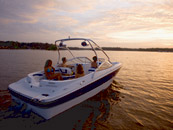Running in limited visibility can be tricky business. Here’s what to do to stay safe when the fog rolls in or the night curtain falls.
By Capt. Stuart Reininger
The boat’s operator claimed he was running at a reasonable and safe speed, even though visibility was less than 100 yards due to a typical New England pea-souper. At the time, the skipper was negotiating a tortuous channel, which under ideal conditions demands a cautious approach. His speed — between 10 and 12 knots — was prudent, he insisted, because his chart plotter/radar indicated he was smackdab in the center of the channel. As an additional precaution, he had stationed his wife on the bow. Seconds before he slammed into the seawall, he thought he was 25 feet clear of the obstruction. His wife, however, spotted the wall and managed to yell a warning before she was catapulted clear over the jetty and into the arms of a terrified fisherman.
The boat suffered massive damage. The skipper fractured his nose when it came in contact with the windshield. The wife and fisherman miraculously came away with just minor scratches and bruises.
That boat owner, a self-described experienced cruiser, said he was flabbergasted to learn he was off course. It’s unfortunate he didn’t know what many commercial towers and marine police do. These professionals say too many accidents that occur in limited visibility are due to excessive speed for the conditions. They also say there has been a rise in careless operation among pleasure boat owners who are blindly adhering to chart displays.
With so much great state-of-the-art technology available, it’s easy for any boat operator to become over-reliant on electronics for navigation. When interfaced with radar and GPS, a chart plotter makes it easy for everyone — including pros — to assume they are viewing real-world conditions in real time at all times. The truth is, there may be moments when a radar unit slips out of tune or when the strength and accuracy of a GPS signal is affected. In addition, sudden changes in water depth and buoy position can render a display outdated. For the most part, an electronics suite will always make navigation easier and safer. I personally think the GPS/chart plotter is the greatest advancement in boating since the planing hull. But in limited visibility, it’s always a good idea to gather information from the electronic displays as well as from other sources and to add a few extra processes to your operating routine.
Conditions that create decreased visibility range from night running to operating in fog, snow and a heavy downpour; sometimes you encounter all of them on the same cruise. I deal with each of these conditions in the same way. First, I’ll adjust the boat speed to my zone of visibility. Second, I enforce a strict "no nonessential lights" policy aboard — only running lights should be turned on. Sharp night vision is as essential as a good compass, yet ambient and reflected light destroys it. I keep the ship darkened belowdecks too. If the boat’s built-in lights do not include a red lens (which won’t affect night vision), I’ll ask the crew to carry a red-lens-equipped flashlight when going below.
Although red lights are key, an essential piece of equipment to have on board in low-visibility conditions is a megawatt spotlight, since you’ll need it to pick out a buoy or an obstruction. However, it can also reflect off the superstructure to create a blinding glare. To prevent that, I tape a cardboard deflector to the business end of the spotlight. Some boats come equipped with built-in spotlights, and those lights are usually situated in such a way that the beam remains focused without creating glare. Those that aren’t mounted quite right are best left for docking only. Carry a portable light for buoy-spotting. Running in heavy fog poses unique challenges. Foremost is the fact that while you may be following proper procedure, another operator may not be. Therefore, I make every effort to determine who is nearby and I let others know where I am. Naturally, radar is important here; just be aware that thick fog (along with rain, snow or sleet) can obscure weaker targets, especially on auto-tune models. For that reason, I keep the set on the lower ranges (one-quarter to three-mile circles) for greater accuracy and then run at appropriate speeds. This way, I can spot a target long before it becomes an issue.
When running at bare steerageway in near nil visibility, I’ll occasionally shut down to eliminate the noise (and the distraction) created by my own engines. I’ll then walk forward (after asking someone in the crew to man the helm) just to listen to what’s going on out there. The results can be surprising. In heavily trafficked areas, I’ve heard boat engines operating at high speeds, yet on occasion I have heard a vessel’s hull passing through the water before hearing its engines. Fog will do that, and it will also give false indications as to where the sound is coming from. This applies to buoys with bells, horns or whistles too.
It’s important to transmit the proper fog signals, and not only because "the rules" require it. A warning signal will let others know you’re nearby and can even alert you to the presence of other vessels. I’ve been in situations where I’ve heard the echo of my own horn off another boat or buoy before I spotted it. Yet surprisingly, it seems as if fewer boats transmit fog signals these days. Basically, it’s good common sense. Likewise, you should keep a lookout and let your presence be known — make security calls on Channels 9 and 16 and display the proper light configuration. For safety’s sake, you should also be prepared to stop and/or change your course instantly if the need arises. Finally, know your exact position in the event you must broadcast it.
Shared with permission by MotorBoating.
